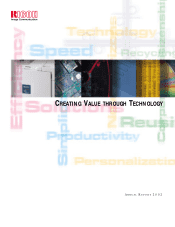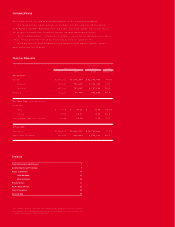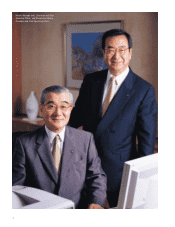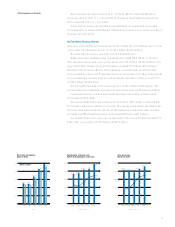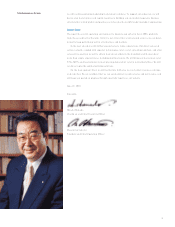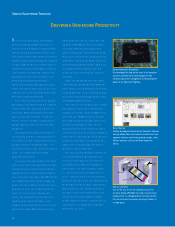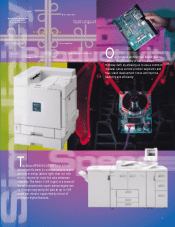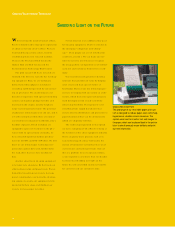Ricoh 2002 Annual Report Download - page 11
Download and view the complete annual report
Please find page 11 of the 2002 Ricoh annual report below. You can navigate through the pages in the report by either clicking on the pages listed below, or by using the keyword search tool below to find specific information within the annual report.
8
While serving the needs of today’s offices,
Ricoh is determined to step up its exploration
of advances for tom orrow’s offices. We have
translated that goal into action, recently
establishing three new research facilities.
They are the Photonics R&D Center, the
Optical Mem ory R&D Center, and the
Environm ental Technology R&D Center.
Our prime goals with basic research are
twinfold. The first is to raise the bar for im ag-
ing equipment. Here, we are working to
deliver faster throughput at resolutions
exceeding 1,200 dots per inch by concentrat-
ing on photonics. We are drawing on our
decades of experience with optical ( including
cameras and optical pickups for CDs) and
materials technologies, notably for photo
large-scale integrated circuits. The potential
of photonics technologies is enorm ous, and it
is worth noting that while there are num er-
ous electronics com panies worldwide, only a
handful of players, Ricoh included, are
equipped to open new horizons in the pho-
tonics field. In optical memory m edia, we
have already helped standardize specifica-
tions for CD-RW and DVD+ RW discs. We will
draw on our technologies to develop next-
generation optical discs and, further down
the road, discs that can store terabytes of
data.
Another objective in im aging equipment
is to target zero emissions. By that we m ean
eliminating energy and paper waste. We are
doing this by seeking new ways to manage
power consumption over networks, develop-
ing systems to ensure our equipment starts
up instantly from sleep, and finding new
ways to increase paper recycling.
Personalization is an additional key goal
for imaging equipment, which is essential in
the emerging “ubiquitous networking”
age— when people can access inform ation
anywhere, any time. We can m ake our sys-
tem s far easier to use if they can recognize
the usage patterns and preferences of individ-
ual users and customize themselves accord-
ingly.
Our second research priority is devising
solutions that provide new value by helping
users create and m anage new forms of
knowledge. Many of our key technology pro-
jects are in keeping with our comm on archi-
tecture, which harnesses open technology to
slash development times and costs while
enhancing flexibility. These projects cover
everything from tagged docum ents that
ensure selective distribution and protection to
paper docum ents that can be electronically
edited or com pletely rewritten.
The technologies pictured in this spread
are j ust a sam pling of what Ricoh is doing at
the forefront of the office equipment industry.
There are plenty m ore projects, such as in
nanotechnology, that m ay well lead to the
erosion of businesses currently at the core of
our revenues and earnings stream . None of
that is a problem for our corporate culture,
as our experience over m ore than six decades
has been that shedding new light on the
future has always yielded enormous benefits
for ourselves and our customers alike.
CREATING VALUE THROUGH TECHNOLOGY
SHEDDING LIGHT ON THE FUTURE
CREATING REWRITABLE PAPER
This prototype of our rewritable paper print sys-
tem is designed to reduce paper costs while help-
ing conserve valuable natural resources. The
system uses heat to transfer text and images to
the paper, which can be placed back in the printer
later to simultaneously erase old data and print
out new information.

